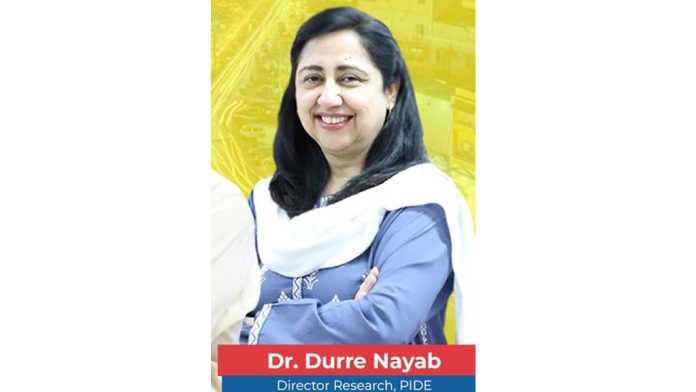Teaching and mentoring others (19.7%) was the most common kind of volunteerism, followed by helping hospitals by providing provisions (12.3%): Dr. Nayab
Islamabad, JAN 8 /DNA/ – Only 3% of Pakistanis are a member of any club. The proportion generally remains low across the country; however, slightly more people are members of any club/organization in urban Pakistan (4%) than rural (2.5%). Among the four provinces, Balochistan has the largest proportion (6.5%) of the population that is a member of any club/organization, followed by Khyber Pakhtunkhwa (3.6%) and Sindh (3%). Punjab has the lowest proportion of 2.4%. On the other hand, Gilgit Baltistan has the largest proportion (13.9%) of club/organization members across all provinces, territories, and regions.
This was revealed in a recent study conducted under the supervision of PIDE Pro Vice Chancellor Dr. Durre Nayab.
The research shows the trends by age and sex that Pakistani males (5%) have a higher rate of club/organization membership than their female counterparts, among whom only 1.1% have any form of membership. The rates generally remain low for all ages but are lowest among the young, i.e., those aged 15-24. The rate is highest for males aged 45-59 and 60 years and above. For females, the rates are extremely low, with those aged 25-34 years (1.9%) having a comparatively higher rate than those in other age groups.
While narrating the research, Dr. Durre Nayab said that Bowling alone is an idea Putnam (2000) gave in his study on the changing American behavior over the decades. Putnam believed Americans were becoming increasingly individualistic and disconnected from structured social structures like clubs, associations, organizations, or bowling leagues. To him, more and more Americans preferred to bowl alone instead of with others or in leagues.
She further added that communities develop when opportunities for social and civic engagement emerge. In the PIDE-BASICS Survey-3, we examined whether they were members of any club or organization and whether they did any volunteer work. If they were, we asked them about the nature of the club/organization and the kind of volunteerism they did. Based on this information, the current Note has seen the trends for social and civic engagement for the four provinces and the three territories and across regions, sex, age, education, and income levels.
According to the Press Release issued by the PIDE, it was said that within the generally low level of club/organization membership rates education shows to have an impact on the proportion of people who are members. The study findings show that Pakistanis who have never been to school have the lowest membership rate in any club/organization. However, the membership rates show an increase as we go up the education ladder, with those having more than high education showing the highest rate (8.1%).
Dr. Nayab, while describing the research details, said that Civic engagement involves actions to improve the quality of life in a community. In the PIDE BASICS Survey, we gauged this through the involvement of people in voluntary work. We found that at the national level, only 9.2% of the people did voluntary work frequently. As found in social engagement, civic engagement was stronger in Balochistan and GB than in other provinces and territories. GB had the highest rate across the country. Punjab had the highest proportion (80.1%) of those not involved in any kind of voluntary work.
She said that the PIDE study shows that volunteerism increases with increasing educational level, with those with higher or more education having the lowest proportion (55%) of those never being involved in voluntary work. In addition, increased income levels are associated with a stronger involvement in voluntary work, as can be seen from the highest income level (fifth quintile) having the lowest proportion (61%) of those never engaged in voluntary work.
“Those reporting to be involved in voluntary work, be it frequent or occasional, were asked the nature of their work. Those involved in more than one kind of work were allowed to give multiple responses. Research findings show that Teaching and mentoring others (19.7%) was the most common kind of volunteerism, followed by helping hospitals by providing provisions (12.3%), picking up rubbish and cleaning (8.7%), and helping people with disabilities (8.3%). A very small proportion (0.8%) was involved in coaching and arranging sports. Some other tasks (5.4%) that people were involved in included helping people out in the neighborhood whenever help was needed, giving food to the needy, performing tasks at mosques, and arranging/donating blood for patients” PIDE Pro VC added.

















